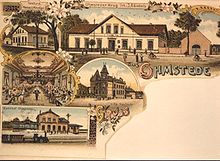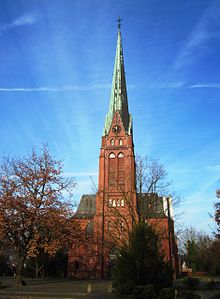Ohmstede
|
Ohmstede
District-free city of Oldenburg (Oldb)
Coordinates: 53 ° 10 ′ 0 ″ N , 8 ° 15 ′ 0 ″ E
|
||
|---|---|---|
| Incorporation : | 1933 | |
| Area code : | 0441 | |
|
Location of Ohmstede in Lower Saxony |
||
Ohmstede ( Low German Ohmstä ) is a district of Oldenburg (Oldb) in Lower Saxony .
The village of Ohmstede
Ohmstede is located in the northeast of Oldenburg and is an old farming village that has probably existed since at least the 9th century. It was first mentioned in a document in 1158. Like many other villages in the region, Ohmstede was an Esch settlement . With twenty Hausmannshöfen Ohmstede was the largest village in the Ammerland , probably also due to its preferred location: in addition to the Geest and Moor (as well as its neighboring villages) Ohmstede had access to the rich pastures and meadows of the Hunte -Marsch. In addition, there was certainly also the proximity to the royal seat of Oldenburg.
The Hausmannshöfe were spread over the districts of Waterende, Loyerende and Överkamp as well as the single yard Schellstede. The settlement of mutts , mostly farmer sons who were leaving, began very early in Ohmstede . This is how the mutt village Bornhorst came into being since the 13th century . On the edge of the Dornsteder Esch lies the district of Kortendorf = Köterdorf.
Ohmstede has belonged to the Oldenburg bailiwick since ancient times. The farmer's letter of April 9, 1700 is handed down as an early legal system. After the French period (1810–1813) Ohmstede became part of the rural community of Oldenburg .
The municipality of Ohmstede 1897–1933
In 1897 the rural community was divided. In addition to Ohmstede itself, the independent municipality of Ohmstede included the villages of Bornhorst, Donnerschwee , Etzhorn , Ipwege , Ipwegermoor , Nadorst and Wahnbek . After the First World War , the Ofenerdiek, which had arisen from a munitions factory, was added. The community continued to be predominantly rural, but the city of Oldenburg slowly began to expand. In Donnerschwee, in particular, there were individual industrial companies, and there were several distilleries in Etzhorn and Wahnbek.
In Ohmstede itself, in addition to a brickworks , there was primarily the Haslinde brewery, probably founded as the Jürgens brewery before 1825 and taken over by Bernhard Haslinde in 1879, who expanded it into a large company. In 1922 it merged with the Donnerschweer brewery Hoyer zu Haslinde-Hoyer , was taken over by Bavaria in 1971 and closed in 1976.
Ohmstede as a district of Oldenburg
Due to the administrative reform of 1933, which was initiated by the NSDAP ruling early in the state of Oldenburg , most of the municipality of Ohmstede came to the independent city of Oldenburg, the villages of Wahnbek, Ipwege and Ipwegermoor went to the municipality of Rastede in the Ammerland district .
During the Second World War , a forced labor camp was built on the former racing course in Ohmstede , in which foreign workers , mostly people from Poland and the Soviet Union , were housed. Many of the forced laborers who died up to 1945 are buried in the Ohmsteder cemetery.
After the war, the well-preserved barracks were converted into a DP camp , which was called the "Lettenlager" because it mainly housed ethnic Latvians and Estonians . Some of them stayed in Ohmstede permanently because, on the one hand, they did not want to return to their homeland, which was occupied by the Soviet Union in 1940 and were again ruled by communists from 1945 , but on the other hand they did not want to emigrate to a country of Germany's western war opponents. In 1960 the wooden houses were torn down and gradually replaced by apartment blocks, into which, however, not only Baltic exiles moved. In the 1970s there were around 300 Latvians in Oldenburg. Many Baltic exiles in Ohmstede neither wanted to become German citizens nor citizens of the Soviet Union; they remained, often to the restoration of the sovereign state of Latvia , stateless . Others acquired German citizenship over time. Most of the Latvians and Estonians who lived in Ohmstede after the Second World War stayed in Germany even after the collapse of communism and the restoration of the sovereignty of the state of Latvia in 1990. The most prominent exiled Latvian who died in the Ohmsteder exile was the Latvian general Rūdolfs Bangerskis .
Today the street names "Rigaer Weg" and "Kurlandallee" as well as a high proportion of Latvian residents of these streets remind of the "Lettenlager".
The population of Ohmstede increased considerably in the second half of the 20th century. Because larger housing estates have also been built on the "Ohmsteder Esch" since the 1950s. Today Ohmstede is a popular residential area on the outskirts of the city of Oldenburg, but it also has several old farms and houses from the 19th century. Three neighboring, thatched- roof Ohmsteder farmhouses burned down in March 2013.
Church community Ohmstede
In terms of church, Ohmstede used to belong to the rural community of Oldenburg, whose parish church St. Lamberti, from 1647 to 1811 St. Nikolai, was in Oldenburg. Since the community covered a huge area and the church paths were correspondingly long, a division of the community had long been under discussion. It was not until 1897 that the synod decided to split it up into the independent parishes of Ohmstede, Ofen , and Eversten .
The new parish of Ohmstede includes the villages of Bornhorst, Donnerschwee, Etzhorn, Ipwege, Ipwegermoor, Nadorst, Ohmstede and Wahnbek. (See also Evangelical Lutheran Church in Oldenburg ).
The new Ohmsteder church was built in the neo-Gothic style (according to the Eisenach regulation ) and was consecrated on December 17, 1901. Unlike almost all other churches, it is not east, but north.
In 1964 a special church for evangelical Balts was opened on Kurlandallee. The number of parishioners decreased. In the 2000s there was only one service a month on Kurlandallee. In 2009 the church was converted into a cultural center. The evangelical Latvians were integrated into the parish of Ohmstede.
Social facilities
- Evangelical Lutheran Church Ohmstede-Etzhorn
- Community center Ohmstede
- Non-profit workshops Oldenburg e. V.
traffic
- railroad
In 1896 Ohmstede received a railway connection through the construction of the Oldenburg – Brake rubber railway . Passenger traffic was discontinued for the winter timetable in 1961. The railway connection was finally closed on May 1st, 1998. The old railway embankment is now a walk (from Kummerkamp to the Hullmann distillery in Etzhorn ).
- Highway
Ohmstede has no direct connection to either of the two federal motorways . At the Oldenburg -Ohmstede / Donnerschwee exit , you can drive onto the A 28 and A 29 via the north bypass . Then you can drive in the direction of Wilhelmshaven , Brake , Bremen , Ahlhorn (or Osnabrück ) and Emden / Leer .
- bus
Ohmstede is connected by the city bus lines 318, 322 and 323 of the Oldenburger Verkehr und Wasser GmbH , as well as the regional line 460 ( Oldenburg, ZOB -Ohmstede- Bornhorst -Großenmeer).
Schools in Ohmstede
- All-day primary school in Ohmstede
- Integrated comprehensive school Flötenteich with upper school level
- Realschule Hochheider Weg
See also: Education in Oldenburg
Sports
Local associations
1. FC Ohmstede, which works in a socially integrative manner in its youth work, is of great importance for the district. With more than 30 youth teams, the club has one of the largest youth departments in northwest Germany. Despite very limited resources (only 3 sports fields on Rennplatzstrasse and on Flötenteich and Schlieffenstrasse), the club has also succeeded in getting a handicapped team, 5 men's and one women's team to participate in the game. The girls' soccer department has a special charisma. The traditional club VfB Oldenburg, on the other hand, is less important. Although four of its numerous training grounds (Dornstede) are in the district, very few children from Ohmstede play here. The VfB has a competitive sports orientation and is home to numerous children from the entire north-west region of Germany. The club offer is supplemented in Ohmstede by the circus school Seifenblase (practice site in the forum of the IGS Flötenteich) and children's gymnastics offers from the SV Eintracht Oldenburg and the Donnerschweer gymnastics club.
Sports fields
- Dornstede (Elsflether Strasse)
- Rennplatz (Rennplatzstraße)
- Sports fields at the Flötenteich ( artificial and natural turf )
Sports halls
- Sports hall at the GS Ohmstede
- Sports hall at the flute pond
Other sports facilities
- Outdoor swimming pool at the Flötenteich
The former gymnastics club Ohmstede, which today belongs to SV Eintracht Oldenburg- Etzhorn e. V., also founded the Ohmstede volunteer fire brigade .
literature
- Ulf Gebken: Social integration through girls' football. Experiences and results in Oldenburg-Ohmstede. (= Oldenburger VorDrucke. 560). Office of the Diz, Oldenburg 2007.
- Heinrich Munderloh: The farmers' associations Ohmstede and Bornhorst. Self-published, Oldenburg 1984.
- KG Böse: The Grand Duchy of Oldenburg. Stalling, Oldenburg 1863. (digitized version)
- The local register for the German Empire. Stollberg, Berlin 1927.
- Anni Hanken: In the Hankenhof in Ohmstede (= Oldenburg family studies . Year 35, issue 2/3). September 1993.
- Ohmsteder Church 100 years between village and town . Oldenburg 2001.
Web links
Individual evidence
- ^ Ekkehard Seeber: Constitutions of Oldenburg peasantry . Univ.-Verlag, Osnabrück 2008, ISBN 978-3-89971-414-2 .
- ↑ Lore and Peter Bachmann: Discovering Alt-Oldenburg. Ohmstede Racecourse
- ↑ Jörg Meier and others: Remember. Former Polish and Ukrainian forced laborers visit Oldenburg . In: Oldenburger Stachel. Issue 188, March 1998, p. 5.
- ^ Volksbund Deutsche Kriegsgräberfürsorge eV: List view of the war cemeteries: Oldenburg-Ohmstede, Städtischer Friedhof.
- ↑ Arvaldis Andrejs Brumanis: The Baltic countries and their exile using the example of Latvia . In: East-West European Perspectives. 1/2006.
- ↑ Gemeinnützige Siedlungsgesellschaft Oldenburg (GSG): Building & Living in and around Oldenburg.
- ↑ Aina Urdze: Approaching Obsolescence (PDF; 863 kB). Lecture at the European University Viadrina Frankfurt (Oder), December 16, 2011, p. 11.
- ^ Sabine Schicke, Evelyn Eveslage: Ohmsteder farmhouses burned down . In: Nordwestzeitung. March 25.2013.
- ^ Gemeinnützige Siedlungsgesellschaft (GSG) Oldenburg: Former church with a new task . 2009.
- ↑ Björn Franke: On the trail of the rubber train. Photo report. Part 2: Wehdestrasse - A29 . ( Memento of the original from October 9, 2012 in the Internet Archive ) Info: The archive link was inserted automatically and has not yet been checked. Please check the original and archive link according to the instructions and then remove this notice. In: Oldenburg local section. October 2, 2012.






